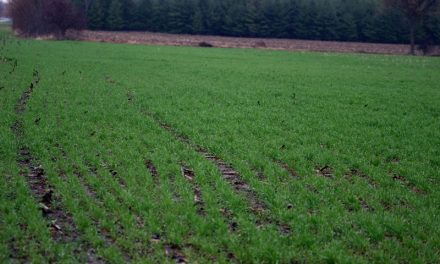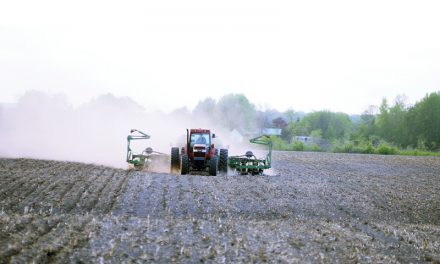The future of farming and improving the bottom line
At the St. Lawrence-Ottawa Valley Christian Farmers Federation of Ontario meeting in Morrisburg, Feb. 9, from left are Brian Vandenberg, Albert Zandbergen and Paul Bootsma. Van Dusen photo
by Tom Van Dusen
AgriNews Staff Writer
MORRISBURG – With the topic of depression and mental illness among farmers gaining more attention, in welcoming participants to the St. Lawrence-Ottawa Valley Christian Farmers Federation of Ontario meeting Feb. 9, regional president Brian Vandenberg urged farmers to keep an eye on their neighbours.
Noting that many farmers and farm families live in semi-isolated situations, Vandenburg urged participants gathered at Morrisburg’s McIntosh Inn to not hold back in offering a hand to someone they might suspect of going through mental health challenges.
There’s nothing wrong, he suggested, in asking a neighbour behaving differently if everything is alright. Experts have noted that troubled farmers, especially the older generation, are less likely to seek outside help; it’s a stigma that must be resolved, they contend.
As farming has evolved into big business relying on technology, the simpler outdoor lifestyle is disappearing; there are additional mental challenges every day.
Organizations like the CFFO are taking a greater interest in the mental health file, pointing out that stress, anxiety, depression, emotional exhaustion and burnout are higher among farmers than other groups. The effects touch families, friends and even the animals that farmers care for.
The occasion was the St. Lawrence-Ottawa Valley chapter’s 2018 annual meeting and policy tour, a format followed over the winter months in CFFO county chapters across the province. Hosted by local executive members, the meetings are boosted by federation headquarters staff, notably field service manager Paul Bootsma.
About 30 members turned out to hear presentations, including a provincial government update from area MPP Jim McDonell and a chapter treasurer’s report showing a healthy balance of close to $11,000 at the end of 2017.
Entitled “The Future of Farming”, the policy tour took a look at the winds of change blowing across modern farming, including equipment innovations and how they can improve the bottom line.
The main topic was about good old-fashioned drainage, where it’s been and where it’s going, from the perspective of area contractor Albert Zandbergen, owner-operator of Quintan Products Inc. of Winchester. Vandenberg said the talk was timely in light of changes in Ontario fish habitat regulations.
Zandbergen refers to himself these days as a “Land Improvement Contractor” because he just doesn’t install tile drainage and clean municipal drains, he also clears and grooms land with a full range of GPS-equipped machinery.
He estimated that $50-million a year is spent on drainage improvements across Ontario. Some 110 contractor licenses have been issued, with about 200 machines working the fields, and an average of $1.5-million invested per business. Annual financial spinoffs are worth up to $7-million, he stated.
Zandbergen’s company excavates up to 25 km of municipal ditches per season, with projects dependent on funding availability and ratepayer demand. Work is done according to engineering plans and, in a drawback noted by Zandbergen, alterations can’t be incorporated on site without expensive and time-consuming reengineering. He suggested most municipal superintendents are competent to approve alterations without any extra engineering.
The contractor cited time constraints in getting jobs done in tighter windows brought on by changing weather patterns, including fall flooding where it hasn’t occurred in the past, earlier planting, extended crop seasons and harvesting days, and crops left standing in the field for extended periods of time. Projects can and do continue through the winter but they’re limited based on overall weather conditions and intermittent thaws.
Farmers in the room had little sympathy for standing corn blocking a drainage project – particularly one involving several neighbours – and insisted the culprits should be ordered to remove it. On an agreement or multi-owner drain improvement, it only takes one hold-out to stall the work.
Changing landscapes can alter a drain classification, causing delays, Zandbergen noted. For example, beavers can build a dam, create a pond, and turn a drainage site into a wetland, bringing habitat restrictions that didn’t exist before. As a sign of good drainage in action, Zandbergen recalled severe flooding in South Dundas Township last November which disappeared within four days.
Among difficulties for rural land improvement contractors is acquiring and keeping good seasonal staff for which they usually have to compete with bigger urban companies. Upkeep on machinery, particularly new technology, is another challenge. Yet another is competition from unlicensed operators.













